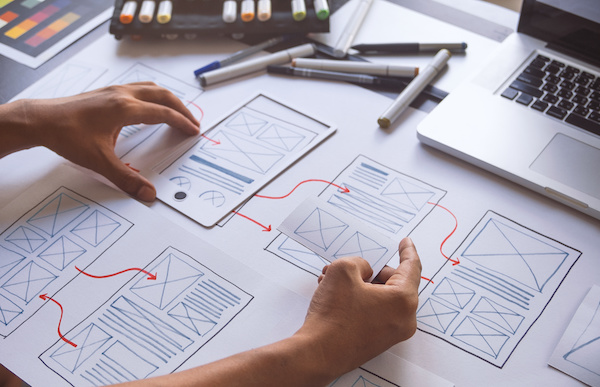
Every professional UX/UI design agency has a set of principles that the team follows in order to be more productive and connected.
If your design team does not follow any rules and is immersed in chaos, this post might help you. Let’s dive in.
The Two Main Principles of Productive UX/UI Design Teamwork:
1. Design Systematization.
When creating and developing a product, a UX or UI design agency uses different solutions and techniques that help fight primary chaos.
In order not to miss anything important, you should implement design systematization. Store layouts sorted by folders and tabs, have a constant set of fonts, types of buttons, icons, proven design solutions, color palettes, somewhere where every member of the team can access them freely.
If you haven’t implemented this principle right from the start, it goes on to sort the entire system, while the product continues to be developed and manufactured. The knowledge base is increasing, and the task becomes more and more challenging. At this point, it is necessary to include a systematization of design. A structured, centralized knowledge base with all the design resources for a particular project or product is also called a design system.
The Benefits of Design Systems.
Unified experience and knowledge base.
Each team member, if necessary, can turn to such a library to learn more about the company’s product, the works of their colleagues, and find answers to their questions. It doesn’t matter if they are a newcomer, a UX analyst, or a layout designer. This will definitely increase the productivity of the project.
Versatility, order, and convenience.
Libraries, approaches, components, principles, and guidelines of the design system free the environment of chaos, bringing clarity to the project, allowing the designer and the team as a whole to concentrate on the most important tasks. This is its order and convenience. Each element of the system may well be modernized, improved, applied, and excluded from the system. This is its versatility.
Speeds up the processes without compromising on quality.
Drawing a grid or a button, choosing their dimensions, color styles, and selecting fonts can be tiring, as it takes up a significant amount of time. When this is in your library of design systems, all that’s left is to choose the right one. Routine actions stop to slow you down.
Overall, design systems significantly speed up and facilitate the routine process, allowing you to vary the library of components, proven solutions, and principles, and also represents a knowledge base for the team, which saves time, understanding, order, and convenience.
A design system can and should develop as a living organism. Proven solutions may become obsolete and components must be updated, but maintain order and follow system principles.
2. Visual Control.
The second principle you may want to implement is a visual control.
The initial design goes through many stages on its way to the final product. On its way, due to technical difficulties and human mistakes, many inconveniences can appear.
In the pursuit of productivity, financial gain, the fulfillment of tasks, deadlines, and the client’s desires, defects will appear and the essence is missed; the main meaning of development is forgotten. The product is not user-friendly and lacks the necessary functionality.
Visual control is a pre-final stage that allows you to identify errors and return to the point where something went wrong in the design.
The Benefits of Visual Inspection.
Error Detection.
By implementing this technique, you can track all those errors that could appear in the process and cause inconsistencies at the early stages.
Quality Control.
This item is directly related to error detection. The designer is responsible for the quality of the visual control at all stages of design, like any other specialist. The lack of intermediate and final visual control means less responsibility. It is important for company executives to monitor this moment, apply, and implement quality control by specialists.
Productivity.
By spending time and energy on quality control and identifying errors, the company and its team prevent possible costs of correcting defects after release, restarting the product, ruining the reputation, replaying deadlines, etc.
As you can see, visual control is merely smart management and quality testing throughout the whole design process. It will help you to make the work of your team more organized and increase productivity.
Final Thoughts.
Every company has secrets that help them to build a more productive workflow. If you’re seeing that the routine that you follow doesn’t work, try to implement design systematization and visual control. There are many cases when these techniques helped to improve the quality of work and boosted productivity in UX/UI design agencies.
The post Fundamental Principles For Every UX/UI Design Team appeared first on Young Upstarts.
via https://www.AiUpNow.com/ by admin, Khareem Sudlow

